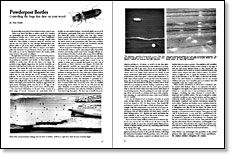
Synopsis: Termites may be the single most destructive wood-eating insect, writes entomologist Tom Parker, but powderpost beetles run a close second. If you catch the infestation early, you can eliminate them before they cause too much destruction. Parker explains the bugs’ life cycle, what types of wood they frequent, and how to tell if the damage to the wood occurred before or after the tree was cut. You’ll learn how to store wood to help prevent inviting the bugs in and how to get rid of them once they’re there. Photos show the bugs themselves and evidence of their damage.
From Fine Woodworking #34
For practically every kind of wood that we have come to use, there is an insect that likes to make a meal of it. Termites are undeniably the most destructive wood-eating bugs, but powderpost beetles run a close second. Once established, powderpost beetles can do enormous damage despite their small size. They display a tenacious talent for survival—one species can even gnaw its way through lead-sheathed telephone cables to get at the paper insulation inside. It’s worth the small amount of time and effort to inspect your lumber piles and structures for powderpost. If you catch an infestation early on, it can be eliminated before the beetles riddle your wood to the point of collapse.
Though there are dozens of species of wood-boring insects, American woodworkers are likely to encounter only two types of powderpost: anobiids and lyctids. A third family, bostrichids, is rarely seen. All are less than 1/4-in. long, the anobiids being slightly larger than the lyctids. Anobiids are found in both hard and softwoods, but they do not infest living trees. The beetle life cycle runs about a year. The adult lays its eggs in checks or cracks in lumber having a moisture content between 8% and 30%. Each egg hatches into a larva which eats its way through the wood, forming circuitous galleries. As the cycle nears its end, the larva pupates into an adult beetle and emerges from the wood leaving a tell-tale round exit or flight hole. The lyctid life cycle is similar, but it infests only large-pored hardwoods, laying its eggs inside the open pores. Emerging adults may lay up to 50 eggs in the same board or they may fly off to a new source of food nearby.
I’ve seen insect infestations in all parts of the country in a wide range of woods. Powerpost are particularly fond of freshly cut and stacked lumber, but they’ll gladly eat wood in old furniture, particularly if the piece doesn’t have a hard surface finish like shellac or lacquer. Ash, oak, elm, walnut, cherry, poplar and a host of softwoods are susceptible to powderpost attack. The beetles eat only the sapwood, feasting on the starch stored in the parenchyma cells. They may occasionally wander into heartwood, but the lack of nutrients and the extractives in heartwood make it unattractive.
Wood suspected of infestation should be inspected closely. On horizontal surfaces, small, crater-shaped piles of powdery sawdust surrounding small round holes strongly indicate active powderpost beetles. Vertical surfaces may show drift lines where the powder has fallen away from the hole and collected on the nearest horizontal surface. Anobiids bore an exit hole 1/16-in. to 1/8-in. in diameter; lyctids leave a hole 1/16-in. or smaller. A better way to identify the beetle is to rub a bit of the powder or “frass” between your fingers. If it feels distinctly granular, anobiids are responsible. Lyctid frass is as fine as talcum powder and virtually disintegrates at the touch.
For the full article, download the PDF below:
Fine Woodworking Recommended Products

Ridgid R4331 Planer

AnchorSeal Log and Lumber End-Grain Sealer

DeWalt 735X Planer





















Log in or create an account to post a comment.
Sign up Log in